
Mantidae is one of the largest families in the order of praying mantises, based on the type species Mantis religiosa; however, most genera are tropical or subtropical. Historically, this was the only family in the order, and many references still use the term "mantid" to refer to any mantis. Technically, however, "mantid" refers only to members of the family Mantidae, and not the 14 remaining families of mantises. Some of the most recent classifications have promoted a number of the mantid subfamilies to the rank of family, e.g. Iridopterygidae, Sibyllidae, Tarachodidae, Thespidae, and Toxoderidae, while other classifications have reduced the number of subfamilies without elevating to higher rank.

Empusidae is a family of plant-mimicking mantises, consisting of 10 genera, holding almost 30 species. Unlike many other mantis families, the Empusidae are a monophyletic lineage. Empusidae mantises are ambush predators, with mouthparts adapted to feeding on other insects and small animals. The majority of Empusidae species are distributed throughout Africa, but they are also found in Southeast Asia and in the southern parts of Europe.

Metallyticus is a genus of praying mantis. It is the only genus in the monotypic family Metallyticidae. They are mostly found in South-East Asia. The species of the genus are dark, somewhat flattened and cockroach-like, and often with a cuticle that is reflective and metallic in appearance.

Mantoida is a genus of praying mantises in the family Mantoididae. The species of this genus are native to Mexico, Central America, and South America.

Hymenopodidae is a family of the order Mantodea (mantises), which contains six subfamilies. Some of the species in this family mimic flowers and are found camouflaged among them; these are called flower mantises. Their coloration is aggressive mimicry, luring prey to approach close enough to be seized and eaten.
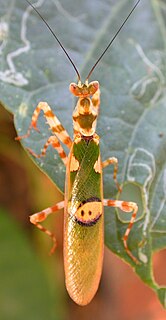
Creobroter is a genus of flower mantises in the tribe Hymenopodini; species are concentrated in Asia. The name comes from the Greek kreo-, meaning "flesh") and broter" meaning "eating", therefore, "flesh-eating", an apt name for a predatory insect. Both sexes have long wings and are capable fliers. Full-grown males are about 3 to 4 cm in length; females are about 4 to 5 cm.

Flower mantises are praying mantis species that display behaviors of mimicry. These insects have specific colorations and behaviors that mimic flowers in their surrounding habitats. The flower mantises are non-nocturnal group with a single ancestry, but the majority of the known species belong to family Hymenopodidea. These animals use a special form of camouflage referred to as Aggressive mimicry, which is used not only to avoid predation but to attract prey as well. This strategy has been observed in other mantises including the stick mantis and dead-leaf mantis. The observed behavior of these mantises includes positioning themselves on a plant and either inserting themselves within the irradiance or on the foliage of the plants until a prey species comes within range. Many species of flower mantises are popular as pets.
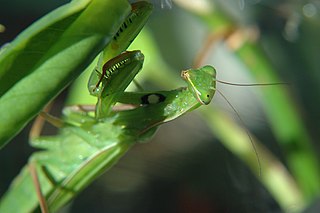
The genus Mantis is in the family Mantidae, of the mantis order Mantodea.
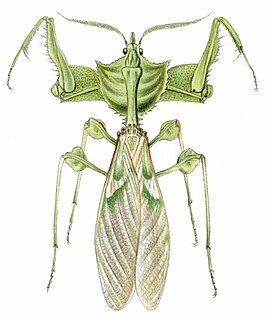
Idolomantis is a genus of praying mantises in the family Empusidae. It is represented by a single species, Idolomantis diabolica, commonly known as the devil's flower mantis or giant devil's flower mantis. It is one of the largest species of praying mantises, and is possibly the largest that mimics flowers

Metallyticus splendidus is a rare species of praying mantis found in Southeast Asia. It has an iridescent appearance.

Myrmecomantis is a genus of praying mantises in the family Nanomantidae. It is monotypic, being represented by the single species, Myrmecomantis atra, commonly known as the ant mantis. It is a species that relies upon ant mimicry for protection even as an adult.

Rhombodera is a genus of praying mantises native to Asia and possessing common names such as shield mantis, hood mantis, and leaf mantis because of their extended, leaf-like thoraxes.
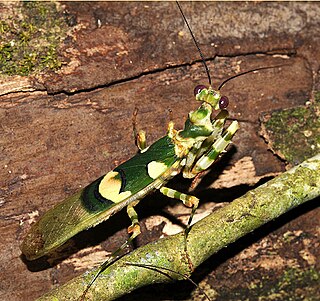
Chlidonoptera is an African genus of praying mantis in the family Hymenopodidae and tribe Hymenopodini.
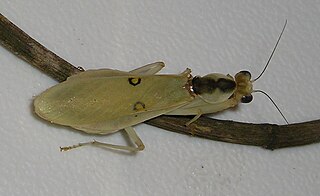
Chloroharpax is a genus of praying mantis in the family Hymenopodidae. The genus is monotypic, being represented by a single species, Chloroharpax modesta, commonly called the Nigerian flower mantis, and is found across West Africa.

Mantises are an order (Mantodea) of insects that contains over 2,400 species in about 460 genera in 33 families. The largest family is the Mantidae ("mantids"). Mantises are distributed worldwide in temperate and tropical habitats. They have triangular heads with bulging eyes supported on flexible necks. Their elongated bodies may or may not have wings, but all Mantodea have forelegs that are greatly enlarged and adapted for catching and gripping prey; their upright posture, while remaining stationary with forearms folded, has led to the common name praying mantis.
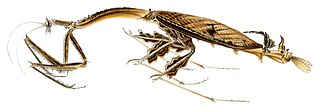
Toxodera is the type genus of mantises in the family Toxoderidae; species are native to South-East Asia. One species, Toxodera denticulata, can reach 200 mm in length.

Pseudocreobotra is a genus of Sub-Saharan flower mantises. They are visually similar to Creobroter species of Asia, but belong to different subfamilies. Their forewings have prominent spiralled eyespots, which are flashed in a silent deimatic display, to startle would-be predators. The nymphs however, expand the raised abdomen in response to threats, to reveal a single dorsal eyespot. The species are easily reared in captivity.

Galinthiadidae is a family of 24 African mantis species in four genera.

Harpagomantis is a genus of praying mantises in the family Galinthiadidae found in Africa. It is monotypic, being represented by the single species Harpagomantis tricolor.


















